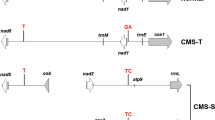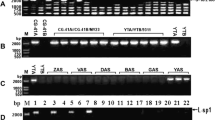Abstract
The organisation of mtDNA was investigated for 28 sources of cytoplasmic male sterility (CMS) and a fertile line (normal cytoplasm) of Helianthus annuus by Southern hybridisation. In addition to nine known mitochondrial genes (atp6, atp9, cob, coxI, coxII, coxIII, 18S, 5S and nd5) three probes for the open reading frames in the rearranged area of PET1, orfH522, orfH708 and orfH873, were used. Genetic similarities of the investigat-ed cytoplasms varied between 0.3 and 1. Cluster analyses using the UPGMA method allowed the distinction of ten mitochondrial (mt) types between the 29 investigated cytoplasms. Most mitochondrial types comprise two or more CMS sources, which could not be further separated, like the PET1-like CMS sources (with the exception of ANO1 and PRR1), or ANN1/ANN2/ANN3, ANN4/ ANN5, ARG3/RIG1, BOL1/EXI1/PEF1/PEP1 and GIG1/ PET2. ANL1, ANL2 and the fertile cytoplasms are also regarded as one mitochondrial type. Unique banding patterns were only observed for ANT1 (atp6), MAX1 (atp6, orfH522 and orfH708) and PRR1 (coxII). However, four of the mitochondrial types showed unique hybridisation signals: ANN4/ANN5 had characteristic bands for atp6 and orfH708, PEF1/PEP1/EXI1/BOL1 for atp6 and coxII, and PET2/GIG1 for atp9. The PET1-like cytoplasms all shared the same patterns for orfH522, orfH708 and cob (except ANO1). It could be demonstrated that CMS sources, like, e.g., PET2 and PEF1, are different from PET1 in mtDNA organisation and the CMS mechanism. Therefore, these CMS sources represent interesting candidates for the development of new hybrid breeding systems based on new CMS mechanisms.
Similar content being viewed by others
Author information
Authors and Affiliations
Additional information
Received: 20 April 2001 / Accepted: 3 August 2001
Rights and permissions
About this article
Cite this article
Horn, R. Molecular diversity of male sterility inducing and male-fertile cytoplasms in the genus Helianthus . Theor Appl Genet 104, 562–570 (2002). https://doi.org/10.1007/s00122-001-0771-6
Issue Date:
DOI: https://doi.org/10.1007/s00122-001-0771-6




